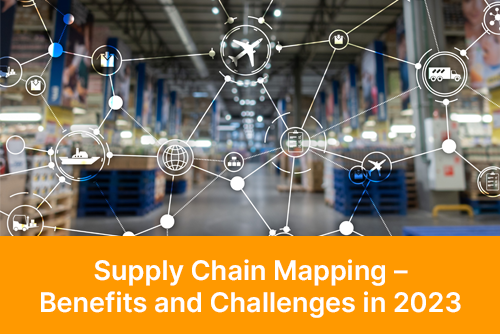Supply Chain Mapping – Benefits and Challenges in 2024
Rohan Sonawane
on
October 23, 2023

Supply chain mapping, just like the name suggests, refers to gathering, storing, and making available crucial information relevant to the manufacturing and shipping of products and services. Supply chain mapping delivers complete visibility, enabling companies to find areas for improvement, reduce the likelihood of vulnerabilities, and stay competitive. As global trade becomes increasingly efficient and businesses continue to broaden their networks, developing and maintaining a detailed understanding of your supply chain is more essential than ever.
Before we explore the why and how of supply chain mapping solution, it’s important to establish what this term means. In simple terms, supply chain mapping captures vital information from all key stakeholders, such as suppliers or individuals involved in an organization’s supply chain, so that the origin points and flow of the products and services can be visualized from an end-to-end perspective.
This concept itself is comparatively easy to understand. Still, once you factor in the complexity of today’s multiple supply chain webs, it becomes harder to gain comprehensive visibility. Not only is mapping in the supply chain important for compliance with regulations and policy, it also enables greater flexibility regarding monitoring possible discrepancies and avoiding potential risks among suppliers.
This article delves into the benefits and challenges of the supply chain mapping technique in the supply chain to gain improved visibility and optimized control.
The role of technology in supply chain mapping for thriving businesses
Thankfully, for many companies, supply chain technology upgrades have made it easier to map a supply chain and enhance supply chain visibility overall. Real-time data facilitates accessing comprehensive information on the supply chain and drawing essential insights from that data.
For instance, demand forecasting software provides more accurate demand predictions by utilizing historical data, shifting customer expectations, and market trends. Step-by-step inventory tracking can also give decision-makers a clear picture of where inventory is at all times and how it’s traveling through a supply chain. As with these examples, technology plays a pivotal role in mapping the supply chain.
Benefits of mapping in supply chain planning
-
Reduced costs
One of the significant benefits of supply chain mapping is the ability to optimize and analyze your spending. A complete view of your supply chain functions and phases lets you access precisely how you spend money and locate which areas are the most cost-effective and which are sizable cost centers. Using these valuable insights, you can reassess your supply chain operations to save both time and money.
-
Enhanced operational efficiency
Supply chain mapping process enables you to scrutinize how different parts of your supply chain are connected, so as to identify supply chain disruptions and pinpoint where delays originate. Effectively managing these problem areas will enhance your supply chain’s overall performance.
For example, if you notice frequent delays from some logistics partners, you can quickly respond to such issues and speed up your deliveries with accurate mapping.
-
Prevent supply chain disruptions
When you have complete visibility into your supply chain, you are better armed to anticipate risks. Mapping your whole supply chain makes it easier to locate supply chain bottlenecks in the early stages and take the necessary actions to mitigate them before they turn into larger problems, and thus develop a more resilient supply chain.
For example, if you pinpoint possible sourcing delays because of a natural disaster in your supplier’s region, you can locate alternate suppliers before your supply is affected and avoid situations like backorders and stockouts.
-
Strengthen your entire supply chain planning
Supply chain mapping company encourages and improves communication among key players in your supply chain. This boosts both coordination between stakeholders and transparency, so that each player clearly understands their responsibilities, roles, and expected targets.
-
Improved customer satisfaction
You might not consider that mapping your organization’s supply chain would impact your customers. However, when you use supply chain mapping software to improves efficiency of your supply chain, risks are averted, costs are decreased, and your existing and potential customers will receive a more positive experience.
Clear visibility into your supply chain facilitates streamlined supply chain functioning and makes it possible for orders to move swiftly through the pipeline and be shipped to customers seamlessly. This structure improves essential supply chain metrics that affect customer satisfaction, lead time, shipping costs, and more.
Common challenges to master supply chain mapping
-
Disintegrated systems and siloed teams
Most business supply chains are complex and require multiple stakeholders. The involved entities may hold information within their respective teams and in their own systems, which may result in difficulty accessing the information you need to map your supply chain because it is restricted within those departments.
-
Inaccurate supply chain planning data
If you don’t have the most up-to-date information about your supply chain operations, you won’t be able to execute informed decisions that benefit your organization. As a result, companies that rely on manual processing and use conventional tools cannot accurately map their supply chains.
-
Poor business communication
Full visibility into your supply chain is only achievable when the departments and stakeholders proactively communicate with one another. If a supply chain stakeholder cannot deliver timely updates or effectively voice concerns, it can result in confusion, unwanted delays, and disruptions for your business.
Accurately detect, shape, and respond to your supply chain disruptions with Avercast
Avercast, A TransImpact Company, offers end-to-end supply chain management solutions that streamline your supply chain operations and improve your decision-making process. Utilizing 250+ algorithms, our solutions enable you to access a powerful dashboard and accurate reporting on your supply chain for optimal cost savings and improved margins. To explore more about our solutions, schedule a demo or talk to our supply chain experts.
- Category: Blogs



